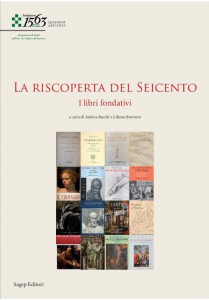Rediscovering Seicento. Foundational writings
by Andrea Bacchi and Liliana Barroero (editors)
«Two years ago, together with Michela di Macco and Giuseppe Dardanello, we set out to organize a seminar for Fondazione 1563’s “Baroque” project and we decided to draw up a list of those books that, in our view, have marked and continue to exert signifcant influence on the study of Italy’s 17th century art.
As the title suggests, we decided not to refer to the term “Baroque” because we’re fully aware of the extensive debate – at times quite heated – that it has spurred. We are also aware that several books that are key to the analysis of aspects which are substantially extraneous to Baroque in its proper meaning – like the so-called “classicist” approach of theorists like Giovanni Battista Agucchi and Giovan Pietro Bellori, analyzed by Denis Mahon in his 1947 text – are also fundamental to understand and contextualize Baroque in its strictest sense (not to mention the question of Caravaggio and the caravaggesque tradition). A case in point was The books that shaped art history: from Gombrich and Greenberg to Alpers and Krauss edited by Richard Shone and Jean-Paul Stonard (Thames and Hudson 2013), which examines sixteen art history books published in the 20th century. In addition to the scholars mentioned in the title, the book features other legendary figures – from Panofsky to Pevsner – but Italian scholars are conspicuously absent and few are also those who have focused specifically on art in Italy, except for Bernard Berenson and Michael Baxandall for the Renaissance, and Francis Haskell for the period of interest here.
By coincidence, our list too consists of sixteen items: it opens with Renaissance und Barock by Heinrich Wölfflin (1888) and closes with Niccolò Maria Pallavicini by Stella Rudolph (1995). With the exception of Wölfflin, all the books were published in the 20th century, starting with Alois Riegl’s that resulted from lectures he held in Vienna in the 1890s and was published posthumously for the frst time in 1908 and then in 1923. We have favoured books of ideas, therefore limiting the number of monographs and including only one exhibition catalogue. There are manuals and inventories (Riegl, Voss, Wittkower, Haskell-Penny), monographs (Longhi, Briganti, Cropper), essays of a general nature (Wölfflin and Argan), books about collecting (Haskell, Rudolph), sculpture (Montagu, Lavin), art theory (Mahon, Sohm) and, as noted, only one catalogue (about the Caravaggio exhibition held in New York and Naples in 1985) that serves to take stock of studies on Caravaggio for the generation that followed Roberto Longhi. We have included two books by one author, Francis Haskell, which are however very different one from the other, and we have also considered that some scholars wrote more than one foundational work: with regard to sculpture, Bernini by Rudolf Wittkower and Algardi by Jennifer Montagu could easily have found their place in our anthology. But then again, Longhi himself appears only with his monograph on Caravaggio, a volume that reflects only one facet of his studies on the Seicento. We also did not include books exclusively concerned with architecture, which will make the object of an ad-hoc seminar to be organized by the Fondazione.
[…] we brought together a group of scholars from different backgrounds and different generations: young PhDs (Elisa Coletta, Valeria di Giuseppe di Paolo, Yuri Primarosa, Stefania Ventra), scholars who have contributed signifcantly to studies on the Seicento (Giovanna Capitelli, Stefano Pierguidi, Lucia Simonato, Maddalena Spagnolo, Maria Cristina Terzaghi, Arnold Witte) and more senior scholars, like myself, Michela di Macco, Tomaso Montanari, Giovanna Perini and Giovanni Romano. Starting in the fall of 2015, three seminars open to public were held in Rome and in these occasions the scholars presented the book they had been asked to concentrate on. Later on, also in the light of what emerged from the seminars and the related debate, we further expanded the list with Wölfflin, Mahon and Elisabeth Cropper’s books.
[…] Clearly, the discussion remains open on various levels: different national traditions, theoretical research vs. research in the field, interdisciplinary openings vs. disciplinary specificity, and much more. The book that you are holding in your hands, instead, aims solely to show that even today it is still essential to address the vastness, the complexity and the contradictory aspects of the Italian artistic Seicento in light of some fundamental vents that led, in the 20th century, to the full rehabilitation of that century. It would therefore appear useful to go through those books that seem to be definitely worth reading and that can be approached, we hope, with renewed awareness thanks to the work of the readers/authors to whom we owe this volume».
Andrea Bacchi, Liliana Barroero

Editors: Andrea Bacchi and Liliana Barroero
Publisher: Sagep Editori (Genova)
Year: 2017
Pages: 288 pp.
Language: Italian
Isbn: 978-88-6373-498-0



